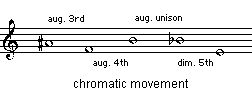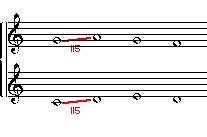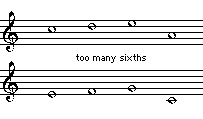
In First Species exercises you'll write note-to-note polyphony: the notes all move together. The voices are rhythmically identical, but aim for independence in their melodic lines. Traditionally these exercises are performed using whole notes, like this exercise in two parts:

In his Modal and Tonal Counterpoint Harold Owen suggests that one could usefully expand first species by allowing different note values, so long as each pitch has only one counterpart pitch in the other voice or voices; he even allows repeated pitches in any voice. You are free to write exercises of that type in the free practice window - just modify the rule about repeated pitches and otherwise keep to first species rules. But to keep things simple we'll make these exercises all in whole notes.
The usual way of proceeding is to write your counterpoint to a cantus firmus (a fixed melody) that is supplied for you. Later you can try writing your own c.f.s, but Counterpointer can generate them for you and also contains the library of c.f.s found in Fux's Gradus ad Parnassum.
 No voice should make a leap larger than a fifth, except for the octave
and the ascending minor sixth.
No voice should make a leap larger than a fifth, except for the octave
and the ascending minor sixth.
 Avoid making successive same-direction leaps in the same voice unless they
outline a triad. If they can't be avoided they should at least total less than an octave.
Avoid making successive same-direction leaps in the same voice unless they
outline a triad. If they can't be avoided they should at least total less than an octave.
 Leaps greater than a fifth should be compensated by movement
in the opposite direction. If the leap is ascending make sure the compensation is stepwise.
Leaps greater than a fifth should be compensated by movement
in the opposite direction. If the leap is ascending make sure the compensation is stepwise.

 A leap of an octave should be balanced: preceded and followed by notes
within the octave.
A leap of an octave should be balanced: preceded and followed by notes
within the octave.

 No voice should move by a chromatic interval (any augmented or diminished
interval).
No voice should move by a chromatic interval (any augmented or diminished
interval).

 Avoid repeating a pitch when possible, especially in the lowest voice. You can
repeat a pitch as many as three times successively if necessary.
Avoid repeating a pitch when possible, especially in the lowest voice. You can
repeat a pitch as many as three times successively if necessary.
 Keep each voice confined to a singable range for the part, preferably not
exceeding a tenth from its highest to its lowest pitch.
Keep each voice confined to a singable range for the part, preferably not
exceeding a tenth from its highest to its lowest pitch.
 Voices all move together in the same rhythm as the cantus firmus. For
traditional exercises all notes are whole notes.
Voices all move together in the same rhythm as the cantus firmus. For
traditional exercises all notes are whole notes.
 Avoid writing parallel fifths or octaves (moving two voices in the same
direction from one fifth or octave to another).
Avoid writing parallel fifths or octaves (moving two voices in the same
direction from one fifth or octave to another).

 Avoid writing direct fifths or octaves (moving two
voices in the same direction to a fifth or an octave). There are exceptions: these may be acceptable at a cadence,
or if one voice is inner and the exposed voice moves stepwise. Direct 5ths in the outer voices will be accepted if the
upper voice moves by step.
Avoid writing direct fifths or octaves (moving two
voices in the same direction to a fifth or an octave). There are exceptions: these may be acceptable at a cadence,
or if one voice is inner and the exposed voice moves stepwise. Direct 5ths in the outer voices will be accepted if the
upper voice moves by step.
 Do not let two voices leap to a
perfect interval unless one of them is an inner part.
Do not let two voices leap to a
perfect interval unless one of them is an inner part.
 Avoid parallel fourths unless the lower tone of the fourth is not the
bass and the pitch class a third below that note is present (that is, parallel
1st-inversion triads are OK).
Avoid parallel fourths unless the lower tone of the fourth is not the
bass and the pitch class a third below that note is present (that is, parallel
1st-inversion triads are OK).

 Avoid writing more than three of the same interval in a row in any two
parts (e.g. four consecutive thirds or four consecutive sixths).
Avoid writing more than three of the same interval in a row in any two
parts (e.g. four consecutive thirds or four consecutive sixths).

 Upper voices can sometimes cross if necessary, but avoid "overlapping"
(in an overlap voices do not cross, but one moves to a position that is at or beyond the previous pitch of another voice).
Upper voices can sometimes cross if necessary, but avoid "overlapping"
(in an overlap voices do not cross, but one moves to a position that is at or beyond the previous pitch of another voice).

 Do not move to an octave with leaping motion in either voice unless the
movement is oblique (one voice remaining on the same pitch).
Do not move to an octave with leaping motion in either voice unless the
movement is oblique (one voice remaining on the same pitch).
 One perfect interval can follow another in the same voices
only if one of the voices moves stepwise.
One perfect interval can follow another in the same voices
only if one of the voices moves stepwise.
 Avoid the unison except at the beginning or end. Authorities disagree: Fux forbids unisons except
at terminals (though he occasionally shows on in his examples). Jeppeson is much more free with unisons. But since these
exercises are mostly based on the Fux method we'll keep his objection to unisons.
Avoid the unison except at the beginning or end. Authorities disagree: Fux forbids unisons except
at terminals (though he occasionally shows on in his examples). Jeppeson is much more free with unisons. But since these
exercises are mostly based on the Fux method we'll keep his objection to unisons.
 In all species of counterpoint, use contrary motion frequently to
emphasize the independence of voices.
In all species of counterpoint, use contrary motion frequently to
emphasize the independence of voices.
 In first species there is no dissonance, so the only harmonic intervals
allowed are the thirds, sixths, fifth, and octave (and, when in 3 parts or more,
the fourth if its lower tone is not the bass). The diminished fifth and augmented fourth
will be considered consonant if they are not formed with the bass. Note also Fux's admonition
that full triads should be used whenever possible, and when that is not possible use thirds and sixths in
preference to "empty" fifths.
In first species there is no dissonance, so the only harmonic intervals
allowed are the thirds, sixths, fifth, and octave (and, when in 3 parts or more,
the fourth if its lower tone is not the bass). The diminished fifth and augmented fourth
will be considered consonant if they are not formed with the bass. Note also Fux's admonition
that full triads should be used whenever possible, and when that is not possible use thirds and sixths in
preference to "empty" fifths.
 If in two parts the music must begin with perfect consonances (octaves, fifths, or unisons)
and end with octaves or unisons. In three or more parts you can begin and end with full triads,
but the ending must be either a major triad or a perfect consonance. Fux advises that if the
mode does not contain a major third over the tonic, then it is best to leave the third out of the final
chord rather than to raise it to a major third. However, a concluding major triad was common practice and is acceptable here.
If in two parts the music must begin with perfect consonances (octaves, fifths, or unisons)
and end with octaves or unisons. In three or more parts you can begin and end with full triads,
but the ending must be either a major triad or a perfect consonance. Fux advises that if the
mode does not contain a major third over the tonic, then it is best to leave the third out of the final
chord rather than to raise it to a major third. However, a concluding major triad was common practice and is acceptable here.
 (As before) Avoid doubling a seventh.
(As before) Avoid doubling a seventh.
 The c.f. will always begin and end with the tonic. If the c.f. is in an
upper voice be sure not to harmonize it with a fifth below at the beginning.
That would give the impression of a different mode.
The c.f. will always begin and end with the tonic. If the c.f. is in an
upper voice be sure not to harmonize it with a fifth below at the beginning.
That would give the impression of a different mode.
 Avoid placing the chromatically altered form of a note immediately adjacent to its unaltered
form in a different voice (i.e. cross relation).
Avoid placing the chromatically altered form of a note immediately adjacent to its unaltered
form in a different voice (i.e. cross relation).
 In two-part writing, avoid adjacent use in different voices of two pitches that
form the tritone (tritone cross relation).
In two-part writing, avoid adjacent use in different voices of two pitches that
form the tritone (tritone cross relation).
 In general keep to the pitch classes of the mode expressed by the cantus firmus. Unless you
transpose a cantus firmus this will in practice mean the "white key" notes in Counterpointer's species exercises. Nonmodal tones
may be introduced, however, if they accord with conventional principles for altered tones.
In general keep to the pitch classes of the mode expressed by the cantus firmus. Unless you
transpose a cantus firmus this will in practice mean the "white key" notes in Counterpointer's species exercises. Nonmodal tones
may be introduced, however, if they accord with conventional principles for altered tones.
© 2011 Ars Nova Software, LLC